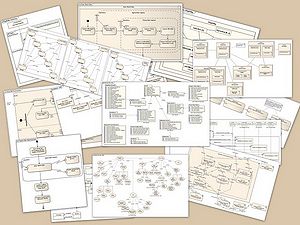Notice: This Wiki is now read only and edits are no longer possible. Please see: https://gitlab.eclipse.org/eclipsefdn/helpdesk/-/wikis/Wiki-shutdown-plan for the plan.
Difference between revisions of "E4/Doc/Preferences"
| Line 17: | Line 17: | ||
Although managing preferences within a variety of scopes can become complex, e4 has streamlined the most common, "80-percent" case. In this default scenario, preferences reside within the scope of an Eclipse instance. This means that when a user switches workspaces, a new set corresponding preferences are applied. | Although managing preferences within a variety of scopes can become complex, e4 has streamlined the most common, "80-percent" case. In this default scenario, preferences reside within the scope of an Eclipse instance. This means that when a user switches workspaces, a new set corresponding preferences are applied. | ||
| − | For situations where greater control of preference behaviour is necessary, e4 provides mechanisms to specify a range of scopes and listen for changes to preferences. For example, a user may want to apply a preference to all workspaces within a single Eclipse install, to a plugin or set of plugins, or to a set of projects within a plugin. Eclipse e4 permits this flexibility of scope, and enables cascading preferences | + | For situations where greater control of preference behaviour is necessary, e4 provides mechanisms to specify a range of scopes and listen for changes to preferences. For example, a user may want to apply a preference to all workspaces within a single Eclipse install, to a plugin or set of plugins, or to a set of projects within a plugin. Eclipse e4 permits this flexibility of scope, and enables cascading preferences through the chaining of scopes in any order. |
== Applicability == | == Applicability == | ||
| − | The | + | The applications of preferences are many: |
| − | * UI customization | + | * UI customization: fonts, window & pane properties, and colors |
| − | * | + | * Installation settings: locations of resources, working directories |
| − | + | * Application settings: internationalization selections, program parameters | |
| − | * Application | + | |
== Implementation == | == Implementation == | ||
Revision as of 20:16, 15 March 2010
The evolution of this document is a collaborative effort between a team of students at the University of Manitoba and the wider Eclipse community. Details about the project can be found here and on our Blog.
Your input is not just welcome; it is needed! Please contribute as your expertise allows, while adhering to our template. To send your feedback and any questions or comments you may have please email us. Also, while we do our very best to be as accurate and precise as possible, it is worth noting that we are students with limited exposure to the Eclipse platform, so if you see any incorrect technical details please let us know.
The ability for users to customize application features according to their individual requirements is often useful. Eclipse e4 provides a mechanism to persist and retrieve these customizations, known as preferences, within a range of scopes.
In the most common case, a user preference is simply a key-value pair that is associated with an Eclipse instance. For example, the preference that specifies that a user would like to have a tool tip displayed on startup could be stored as "showToolTip=true".
Relevant Terms
- Key - A key is a unique string identifier for a preference setting.
- Value - A value is the current preference setting associated with a key, within a specific scope.
- Eclipse instance - An Eclipse instance is synonymous with a workspace. In the context of preferences, an instance scope is valid while using a specific workspace.
Motivation
Although managing preferences within a variety of scopes can become complex, e4 has streamlined the most common, "80-percent" case. In this default scenario, preferences reside within the scope of an Eclipse instance. This means that when a user switches workspaces, a new set corresponding preferences are applied.
For situations where greater control of preference behaviour is necessary, e4 provides mechanisms to specify a range of scopes and listen for changes to preferences. For example, a user may want to apply a preference to all workspaces within a single Eclipse install, to a plugin or set of plugins, or to a set of projects within a plugin. Eclipse e4 permits this flexibility of scope, and enables cascading preferences through the chaining of scopes in any order.
Applicability
The applications of preferences are many:
- UI customization: fonts, window & pane properties, and colors
- Installation settings: locations of resources, working directories
- Application settings: internationalization selections, program parameters

